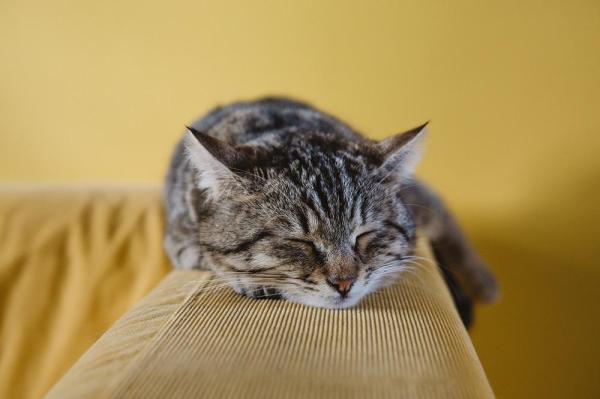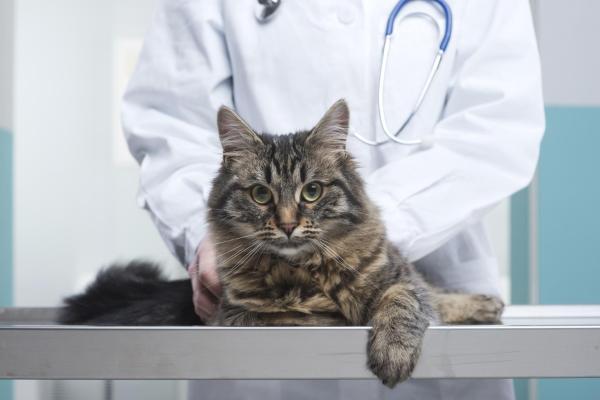
Feline hyperthyroidism is a disease which can often go unnoticed. The disease progresses and begins to affect hormone production in the cat incrementally. As our communication with our cat relies on observing their body language and behavior, there may not be much evidence of a change. This is at least until the cat's behavioral problems become more acute. This is why it is so important to look out for the symptoms of hyperthyroidism in cats. In doing so, we might be able to spot it early and begin treatment sooner.
AnimalWised also gives more background into a cat's overactive thyroid by looking at the causes and treatment of feline hyperthyroidism. We'll also provide some information on what to expect in terms of prognosis and life expectancy.
What is feline hyperthyroidism?
Hyperthyroidism is sometimes known as an overactive thyroid. The thyroid is an endocrine gland located in the neck of the cat, meaning it is part of the endocrine system. This is the part of the body which functions to release hormones which, in turn, helps organs to function properly. If the gland is overactive, it releases too much hormone into the bloodstream and can cause serious problems. In particular, the thyroid regulates the metabolism of the cat, i.e. the rate at which it processes food into its useful component parts.
In cats, hyperthyroidism was not documented until 1979. Unfortunately, there has been a ‘dramatic increase in the prevalence of hyperthyroidism in cats’[1]since its discovery. It is now the most common endocrine disorder in cats and has a significant impact on the morbidity of older cats.
The hormones which the thyroid overproduces are T3 (triiodothyronine) and T4 (thyroxine). Detected in time, there is a much better chance of controlling and improving the symptoms of hyperthyroidism. If not, the consequences of this disorder in cats can have potentially lethal consequences.

Causes of hyperthyroidism in cats
As we reference above, the cause of hyperthyroidism in cats is overproduction of the T3 and T4 hormones in the gland. What cause this overproduction is not completely understood. A recent study from the Irish Veterinary Journal sums it up as follows:
Although the clinical and pathological features of this disease have been well-described, the exact cause(s) remains elusive. Many hypotheses have been explored such as immunological, infectious, nutritional, environmental and genetic factors, but a single dominant factor, other than advanced age, has not yet been identified[2].
In terms of nutrition, it has been suggested that quality other than type may have some influencing factors. There may be some association between canned food and the disease, especially cans which use a ring-pull. Also, an exposure to chemicals such as fertilizers or insecticides might be an influencing factor. This means we need to be careful of environmental factors, but the research is so limited it is difficult to know specifics.
One throughline appears to be the fact that it is more prevalent in certain breeds. These breeds are the Siamese, Burmese and Himalayan, suggesting it particularly affects cat breeds of Asian origin. From this we may be able to assume that genetic factors play some part in the prevalence of the condition. Also, since these three breeds exhibit various levels of colorpoint pattern on their coat, it is possible this has something to do with the colorpoint gene.
In less than 5% of cases, cats affected by hyperthyroidism have a concurrent malignant carcinoma (mass of cancerous tissue)[3]. In these instances, the prognosis of improvement is greatly reduced.
Symptoms of hyperthyroidism in cats
One of the most problematic aspects of hyperthyroidism in cats is the fact that it can be seemingly asymptomatic (without symptoms) for a long time. The clinical signs of feline hyperthyroidism often only appear when it has progressed and treatment becomes more difficult. Paying attention to your cat's behavior and physical appearance is very important for this reason. Regular veterinary checkups are also recommended. They can run tests on organ function which can help us to know their health status.
One of the most common red flags is that the cat's food intake increases, but they do not appear to put on weight. In fact, cats can often lose weight while still eating more than their normal amount of daily food. When the problem becomes alarming, you may observe the following symptoms of hyperthyroidism in cats:
- Chronic diarrhea
- Depression
- Hyperactivity
- Nervous or strange behavior
- Frequent vomiting
- Inability to jump
- Loss of strength
- Neglected and knotted coat
- Arrhythmia
- Dyspnoea (labored breathing)
- Disorientation
- Aggressiveness
- Unusual nocturnal vocalizations
These clinical signs of hyperthyroidism in cats do not appear suddenly or all at once. Instead, they develop progressively. If we neglect our cat's care, the it is possible we overlook these symptoms. When the thyroid increases hormone production it can affect other organs in the body. Kidney function is particularly affected and, if not managed properly, can lead to fatal kidney failure in cats.

Diagnosis of hyperthyroidism in cats
In principle, you should be able to register hyperthyroidism by feeling an enlargement of the thyroid gland itself. This may be felt when petting them under the chin or on the neck. However, you may not be aware of just how large the thyroid should be, so a veterinarian's examination will still be necessary. This alone cannot diagnose hyperthyroidism as there are other reasons you might find a lump in your cat's neck. Also, not all cases of hyperthyroidism will necessarily have an enlarged thyroid.
To confirm diagnosis of feline hyperthyroidism, veterinary medical tests are necessary. The most important diagnostic tool is a complete blood test. This will let us know not only the state of the white blood cells, but will let us know the levels of liver enzymes which are essential in detecting kidney problems. Blood tests also let us know the general state of health of the cat.
In addition an electrocardiogram may be utilized. This will help us evaluate the possibility of a cardiac problem in the cat such as arrhythmia or tachycardia. A biopsy may be performed if cancerous carcinoma is suspected.
Treatment of hyperthyroidism in cats
When the results come back and the cat has tested positive for hyperthyroidism, there are three types of recommended treatments. Which one is available or suitable for your cat will depend on various factors. One is your country of residence as not all treatments are available worldwide. Also, the age, weight and general health status of the cat are very important. If there are complications such as liver malfunctioning or cardiac problems, the type of treatment will be affected.
- The first option is to administer anti-thyroid drugs, a course of treatment which will likely continue for the rest of their life. The option is not curative as it will not eliminate the origin of the problem, but it will hopefully manage the symptoms by stabilizing hormone production in the thyroid. It is possible side effects will occur, so it is recommended the dosage is reviewed every 3 months so it can be adjusted if necessary. A drug like methimazole for cats is effective in blocking hormone secretion and is relatively safe for use in cats[4].
- The second option is a thyroidectomy, which is the name of the procedure for surgical removal of the thyroid gland. This action can eradicate much of the problem, although there is a mortality risk in any such surgical procedure. Usually, a post-surgery chemical therapy is also administered. This will help reduce the chances of death after surgery. The veterinarian should not allow this option if the cat suffers from certain ailments such as liver disease or diabetes.
- The last possible treatment of hyperthyroidism in cats is the use of radioactive iodine treatment (radioiodine 131). This is considered the most effective option by specialists. However, it is not available in all countries and may be prohibitively expensive for some cat guardians.
With radioactive iodine treatment, the tissue which grows abnormally is removed, but the thyroid gland is left intact. In the process it reduces the secretion levels of the hormones. The treatment is administered subcutaneously and it is relatively low risk to the cat. Additionally, less than 10% of feline patients require a second dose, attesting to its high effectiveness.
There are pros and cons for each type of hyperthyroidism treatment. You will need to consider many factors to do with your individual cat, so frank discussion with your veterinarian is essential.

What is the life expectancy of cats with hyperthyroidism?
Unfortunately, there is no blanket answer to this question. The status of your individual cat will affect their life expectancy. Part of the complication is that the majority of cats diagnosed with hyperthyroidism are elderly cats. These cats may not have much longevity to begin with. What we do know is that radioiodine 131 appears to be the best chance for longer term survival.
There are some aspects which can affect life expectancy for cats with hyperthyroidism. One of the most recent studies showed that low-body weight and being male are associated with shorter survival times[5].
One of the first signs of hyperthyroidism in cats is strange or erratic behavior. Learn about other reasons for these changes with our video below:

This article is purely informative. AnimalWised does not have the authority to prescribe any veterinary treatment or create a diagnosis. We invite you to take your pet to the veterinarian if they are suffering from any condition or pain.
If you want to read similar articles to Symptoms of Hyperthyroidism in Cats, we recommend you visit our Other health problems category.
1. Peterson M. (2012). Hyperthyroidism in cats: what's causing this epidemic of thyroid disease and can we prevent it?. Journal of feline medicine and surgery, 14(11), 804–818. https://doi.org/10.1177/1098612X12464462
https://www.researchgate.net/publication/232534900_Hyperthyroidism_in_Cats_What's_causing_this_epidemic_of_thyroid_disease_and_can_we_prevent_it
2. Bree, L., Gallagher, B. A., Shiel, R. E., & Mooney, C. T. (2018). Prevalence and risk factors for hyperthyroidism in Irish cats from the greater Dublin area. Irish veterinary journal, 71(2). https://doi.org/10.1186/s13620-017-0113-x
https://www.ncbi.nlm.nih.gov/pmc/articles/PMC5769238/
3. Scott-Moncrieff, J. C. (2015). 4. Feline Hyperthyroidism (Thyrotoxicosis). In E. Feldman, R. Nelson, C. Reusch, J. C. Scott-Moncrieff (Eds.), Canine and Feline Endocrinology (pp. 136-195). W. B. Saunders. https://doi.org/10.1016/B978-1-4557-4456-5.00004-3.
https://www.sciencedirect.com/science/article/pii/B9781455744565000043
4. Peterson, M. E., Kintzer, P. P., & Hurvitz, A. I. (1988). Methimazole treatment of 262 cats with hyperthyroidism. Journal of veterinary internal medicine, 2(3), 150–157. https://doi.org/10.1111/j.1939-1676.1988.tb02812.x
https://onlinelibrary.wiley.com/doi/abs/10.1111/j.1939-1676.1988.tb02812.x
5